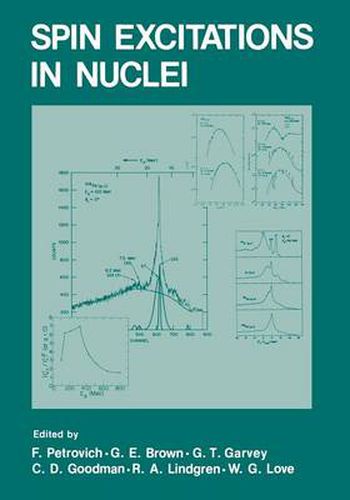Readings Newsletter
Become a Readings Member to make your shopping experience even easier.
Sign in or sign up for free!
You’re not far away from qualifying for FREE standard shipping within Australia
You’ve qualified for FREE standard shipping within Australia
The cart is loading…






This title is printed to order. This book may have been self-published. If so, we cannot guarantee the quality of the content. In the main most books will have gone through the editing process however some may not. We therefore suggest that you be aware of this before ordering this book. If in doubt check either the author or publisher’s details as we are unable to accept any returns unless they are faulty. Please contact us if you have any questions.
This volume contains the proceedings of the International Conference on Spin Excitations in Nuclei held in Telluride, Colo rado, March 25-27, 1982. The motivation for the conference was, in a large part due to the recent development of new variable energy accelerators which produce high quality beams of electrons, protons, and pions that are providing the first precise information on spin excitations in nuclei over a large range of spin and mass. In the past such data had been restricted primarily to light nuclei and were generally resolution limited. Perhaps, the most exciting new result has been the clear observation of the elusive spin-dipole strength (Gamow Teller and Ml) in medium and heavy mass nuclei through the use of the (p,n) and (p,p’) reactions at or near zero degrees with 100-200 MeV incident protons. Energy dependence in the isovector parts of the nucleon-nucleon interaction make the 100-200 MeV energy region particularly appropriate for such studies. The clean data from (e,e’), (‘IT,'IT’), (p,p’), and (p,n) on high spin stretched states which have particularly simple structure has also been quite impor tant. The recent results contain important new information on the nature of the spin dependent forces in nuclei. These in turn are inherently related to the properties of the nuclear mesonic field and the underlying quantum chromodynamics.
$9.00 standard shipping within Australia
FREE standard shipping within Australia for orders over $100.00
Express & International shipping calculated at checkout
This title is printed to order. This book may have been self-published. If so, we cannot guarantee the quality of the content. In the main most books will have gone through the editing process however some may not. We therefore suggest that you be aware of this before ordering this book. If in doubt check either the author or publisher’s details as we are unable to accept any returns unless they are faulty. Please contact us if you have any questions.
This volume contains the proceedings of the International Conference on Spin Excitations in Nuclei held in Telluride, Colo rado, March 25-27, 1982. The motivation for the conference was, in a large part due to the recent development of new variable energy accelerators which produce high quality beams of electrons, protons, and pions that are providing the first precise information on spin excitations in nuclei over a large range of spin and mass. In the past such data had been restricted primarily to light nuclei and were generally resolution limited. Perhaps, the most exciting new result has been the clear observation of the elusive spin-dipole strength (Gamow Teller and Ml) in medium and heavy mass nuclei through the use of the (p,n) and (p,p’) reactions at or near zero degrees with 100-200 MeV incident protons. Energy dependence in the isovector parts of the nucleon-nucleon interaction make the 100-200 MeV energy region particularly appropriate for such studies. The clean data from (e,e’), (‘IT,'IT’), (p,p’), and (p,n) on high spin stretched states which have particularly simple structure has also been quite impor tant. The recent results contain important new information on the nature of the spin dependent forces in nuclei. These in turn are inherently related to the properties of the nuclear mesonic field and the underlying quantum chromodynamics.